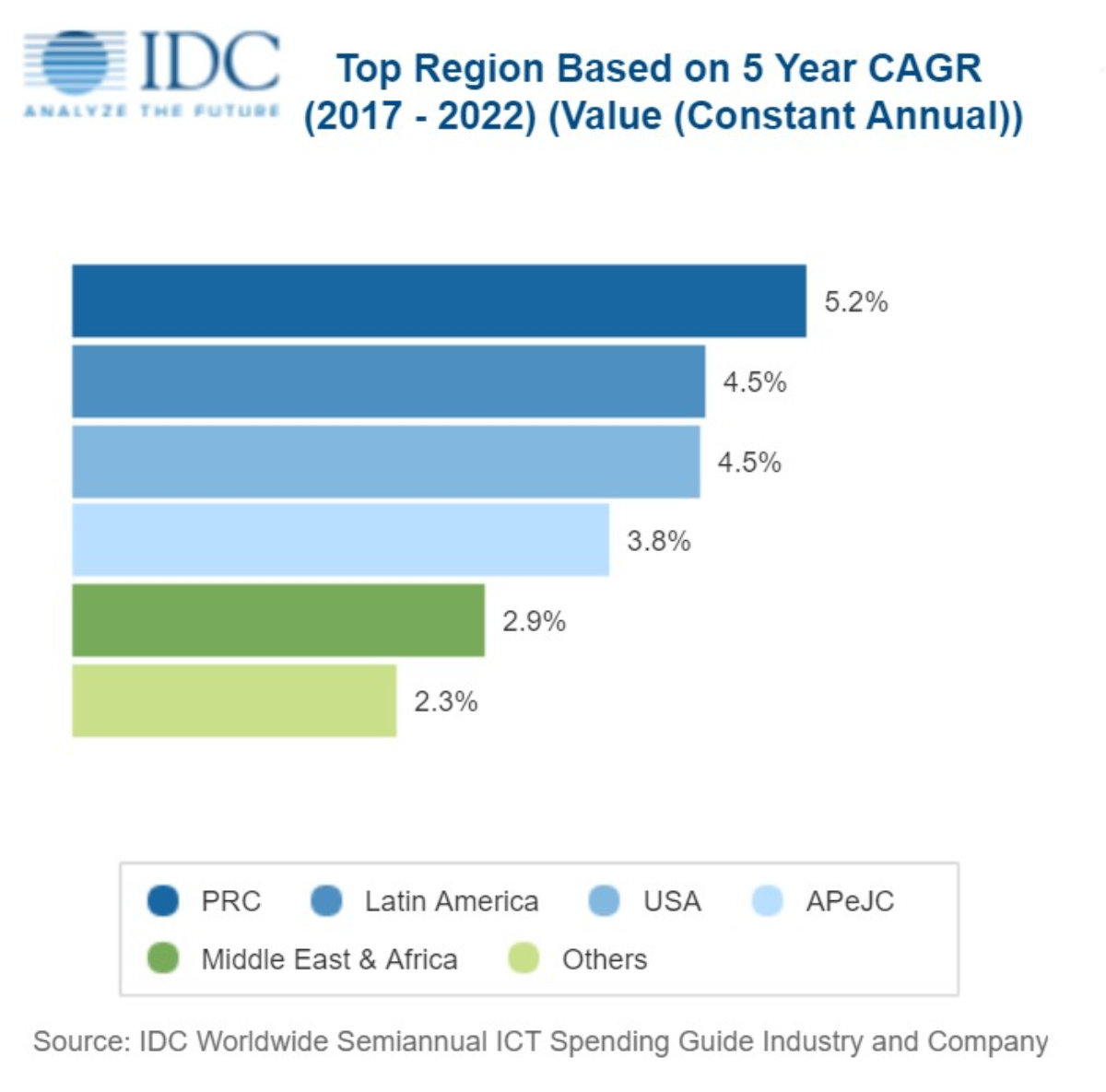Business spending on information and communication technologies (ICT) will be caught in the crossfire of headwinds and tailwinds over the next five years as a softening global economy puts pressure on the ability of organizations to increase technology budgets while at the same time their growth and competitiveness is increasingly dependent on digital transformation, artificial intelligence (AI), and data analytics.
A new forecast from International Data Corporation (IDC) predicts worldwide ICT spending on hardware, software, services and telecommunications will reach $4.6 trillion by 2022, representing average growth of 4% per year. Commercial customers will represent around 63.5% of total spending by 2022 ($2.9 trillion), while consumers will still account for 36.5% ($1.7 trillion).
Consumer spending growth will lag behind business and government spending due to increasing saturation in smartphones and tablets, predicts the research group. The fastest growth over the forecast period will come from the professional services segment (7%), including cloud and digital service providers, which will account for a rapidly increasing share of overall tech spending thanks largely to the explosive growth of cloud infrastructure providers.
Other fast-growing segments include media (+6%), banking (+5%), retail (+5%), and manufacturing (+5%), while the slowest growth in commercial technology budgets will come from federal government, followed by wholesale and construction firms.
“In the short term, the trade war between the U.S. and China continues to add volatility to the outlook,” said Stephen Minton, vice president in IDC’s Customer Insights & Analysis group. “Some firms are also facing the double whammy of weaker sales in China, an increasingly important export market for the manufacturing industry. Meanwhile, the impact in China itself could persist over a longer period of time, with manufacturing and financial services firms being the most exposed.”
In Asia/Pacific, the U.S.-China trade war is a double-edged sword, which presents both challenges and opportunities. Many businesses are increasingly dependent on China for revenue and might be expected to continue their pivot away from the U.S. in trading relationships. On the other hand, the conflict opens up opportunities to increase exports to the U.S. market.
“The trade war undoubtedly presents opportunities for India’s manufacturing sector,” said Ashutosh Bisht, senior research manager for Asia/Pacific in IDC’s Customer Insights & Analysis group. “Many firms in Asia, however, will be forced to try and balance their relationship with both the U.S. and China, and will mostly suffer negatively from any escalation.”
Countering negative sentiment around the economy in China is increasing demand for ICT solutions related to digital transformation. This is driving major investments by large enterprise and state-owned customers in industries such as retail, manufacturing, healthcare, and financial services, especially around cloud and AI. Digital transformation is also driving technology budgets in Europe.
“Companies in Western Europe are not only looking to embrace new technologies like AI and robotics to improve their business processes, but also adopting more customer-centric approaches to IT spending decisions,” said Andrea Minonne, research analyst for Western Europe in IDC’s Customer Insights & Analysis group. “This is especially true in customer-facing industries like retail, banking, transportation, and telecommunications.”
Overall growth in Western Europe will slightly lag emerging markets in Asia/Pacific over the forecast period, but the U.S. market is set to post some of the strongest growth rates in spite of its relative maturity. Business investments in digital transformation, cloud, and AI will help drive overall U.S. growth of 4.5% over the forecast, equaling Latin America as the second fastest growing region for total ICT spending after China.
“In the U.S., the professional services industry is expected to continue with strong technology growth and investments. The appetite for cloud-based delivery, new apps, and tech-fueled services show no signs of slowing, and thus we are optimistic about the growth opportunity for this industry,” said Jessica Goepfert, vice president in IDC’s Customer Insights and Analysis group. “Consumer-driven industries such as retail and hospitality are benefitting from higher wages and disposable incomes. In response, firms in this space are working to develop and deliver unforgettable customer interactions. This takes shape as customizable experiences and infusing technology into their operations. For instance, hotels are implementing technology in guest rooms that can be controlled by mobile apps.”



